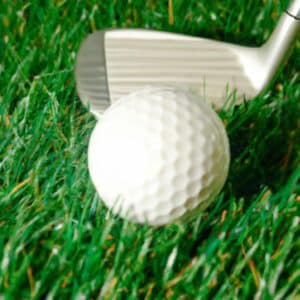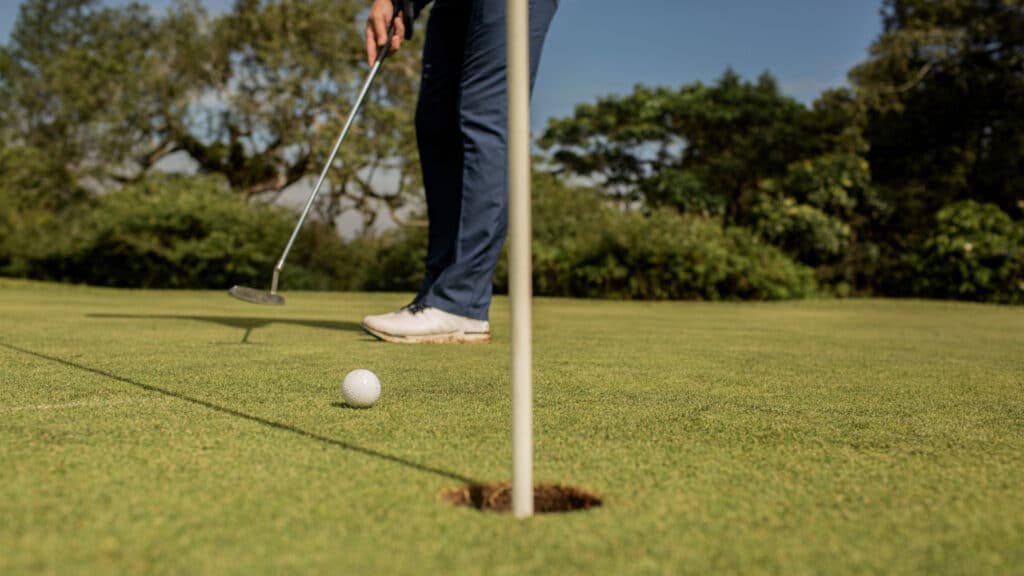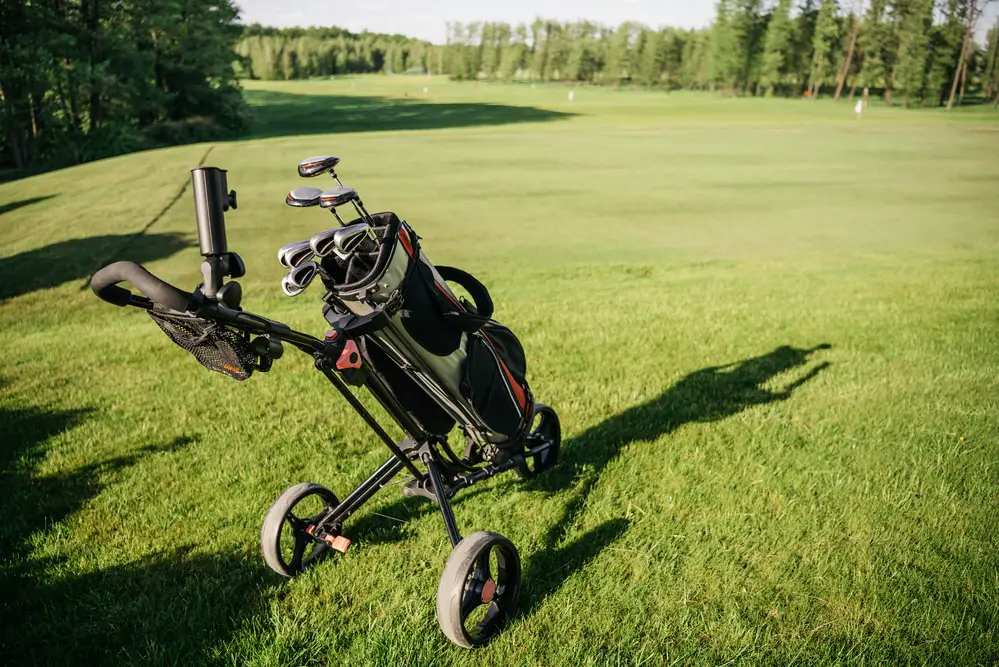Last Updated on June 7, 2023
Golf is a challenging sport that requires accuracy, skill and strength. Determining the distance of your golf club is an important part of becoming a successful golfer. Knowing how far you can hit with each club in your bag will help you adjust to different conditions on the course and make better decisions about which clubs you should use for specific shots. With some practice, you’ll soon be able to determine the exact distances of each club in your set.
Basics Of Golf Club Mechanics
Golf mechanics involve the use of a golf club and understanding how it works. The club face, shaft length, weight, and swing plane all affect the distance that your ball will travel. Understanding these factors can help you determine an optimal distance for each shot.
The angle of the club face when hitting the ball is important in determining its direction and trajectory. A shorter shaft length allows greater control while swinging, whereas a longer one gives more power to the shot. Additionally, heavier clubs require more strength during swings but produce faster shots than lighter ones. Finally, having a proper form on your swing plane is key to getting maximum distance with every stroke. Knowing how much force should be applied at each point helps ensure consistent results from every swing. By taking into account these various elements, golfers can develop their own system for finding the best possible distance for any given situation.
Types Of Golf Clubs
Now that you understand the basics of golf club mechanics, it’s time to learn about the different types. Golf irons are used for mid-to-long range shots and come in a variety of sizes and shapes. They’re usually made from stainless steel and have deep grooves along the faces, which help create a backspin as the ball is hit. Golf wedges are similar to irons, but they have a more angled head, making them ideal for shots around bunkers and other areas with sand traps. Next up are golf putters; these clubs are designed specifically for putting on even surfaces like greens and fairways. Their shorter shafts make them easier to control than full-swing clubs, allowing you to stroke your ball confidently towards its target. Finally, there are golf hybrids – these combine characteristics of both woods and irons, so they can be used in a wide array of situations depending on how far off the tee you need to go. All these clubs will help you add distance to your game, whether you’re hitting short or long shots!
Factors Affecting Distance

There are several factors that can affect a golfer’s distance, each of which must be considered when determining the best clubs for their game. The golf ball is one factor to consider; its size, weight and composition all play a role in how far it will travel. Spin rate also affects the flight path; high spin rates cause balls to fly higher in the air with less roll on landing. Aerodynamics and shaft flex are two other important considerations as they influence club head speed at impact. Lastly, face angle impacts the direction of the shot, an important aspect if you want accuracy as well as distance.
When choosing your clubs, it’s essential to understand these elements and take them into account so that you get the maximum performance out of your equipment. With knowledge of these factors, you’ll be able to find just what you need:
- An optimized golf ball for improved launch conditions
- Low spin rate for optimum carry distances
- Maximum aerodynamic efficiency from your driver
- Shaft flex tailored for swing speed and control
The right combination of these aspects can make all the difference between a mediocre round and playing your best golf ever!
Understanding Swing Speed
Understanding swing speed is an important part of determining golf club distance. Swing speed analysis can help you understand how to accurately use your clubs for maximum performance and accuracy. To give yourself a better understanding of your swing mechanics, consider the following table:
| Swing Speed Analysis | Understanding Swing Speed | Swing Speed Mechanics |
|---|---|---|
| Using a radar device or launch monitor to measure ball speed and other characteristics from each shot struck during practice. Gathering data on previous swings and shots struck during play. | Analyzing various components of your swing such as tempo, width of arc, release point, angle of attack. Comparing results against past rounds and different courses. | Utilizing specific drills like weighted training aids; working on basic grip, stance, posture and alignment; developing a smooth rhythm with consistent tempo throughout the backswing. Incorporating fitness into your routine to increase power output. |
By analyzing your current swing speed metrics, you will be able to identify weak areas in need of improvement so that you can consistently hit longer distances with all club types. With proper understanding comes valuable insight into what changes should be made in order to maximize efficiency while executing each stroke. Through a regular focus on key elements such as swing speed tips, drills and mechanics, you’ll find that hitting further isn’t just about swinging faster – it’s about making smart adjustments to improve technique and overall performance.
Adjustments To Improve Distance
Once you have a grasp on your own swing speed, the next step is to make adjustments to improve distance. This can be done through club fitting and making small changes in your golf swing. Club fitting involves adjusting the length, weight, and shaft flex of your clubs for optimal performance. Additionally, slight alterations to your stance, grip, or backswing may also produce better ball flight and increase your distance range.
When looking for ways to improve distance, it is best to consult with an experienced professional who understands how different club adjustments affect ball flight. A certified instructor can help you analyze what modifications will work best for you based on various aspects such as technique, strength, and flexibility. With their expertise and guidance, you can find the ideal combination of club adjustments that will maximize your driving power and add extra yards off the tee box.
Testing Different Clubs
Testing different golf clubs for distance is an important part of the game. There are several methods that can be used to test a club’s accuracy and effectiveness. To get accurate results, it’s best to use multiple club testing methods. This ensures that all factors, including form, swing speed, ball compression, and shaft flex, are taken into account when club testing for distance.
When testing different clubs, it’s important to consider both the distance you hit with each one as well as the consistency of your shots. The goal should always be a maximum performance from any given club. Club testing done over time will help golfers understand which clubs they need in their bag to optimize their game. Results from these tests can also allow them to make adjustments in terms of grip size or shaft type if needed. With knowledge of what works best for each individual player, distances become more consistent, and scores improve.
Using A Launch Monitor
In order to accurately measure the distance a golf club can hit a ball, one must use a launch monitor. Launch monitors are devices used to measure and analyze specific aspects of an individual’s golf swing, namely ball speed, swing angle, and clubhead speed. Using these metrics can help one understand how far they will be able to drive the ball with each club in their bag.
There are numerous benefits that come with using a launch monitor:
- Increased Accuracy
- A launch monitor measures all characteristics of your swing, which allows you to get more precise feedback on what works best for you. This helps eliminate guesswork when it comes to finding the right clubs for your game.
- Improved Consistency
- Launch monitors provide personalized data about every shot you take so you can see what parts of your swings need improvement in order to make them consistent from shot to shot.

The key takeaway is that using a launch monitor provides invaluable insight into how different clubs perform given certain conditions like wind direction or course layout. Having this information available enables players to customize their equipment setup for maximum performance on any given day of the course. With this knowledge, golfers can confidently select the correct clubs for their particular needs and optimize their chances of shooting low scores round after round.
Estimating With Technology
Technology has made it easier than ever to determine how far you can hit your golf clubs. A GPS device or a golf-tracker app can be used to measure the distances of each shot, while swing analyzers and launch angle calculators help analyze performance. With the right tools in hand, you can quickly get an idea of which club is best suited for different types of shots.
Using these devices also allows players to track their progress over time. They can compare changes in their distance and accuracy as they practice and fine tune their game. This data can then be used to make adjustments and develop better strategies going forward. Overall, technology provides invaluable assistance when trying to maximize distance with every shot.
Utilizing Rangefinders
Rangefinders are an essential tool for golf distance measurement. Rangefinder technology provides precise measurements of the course, allowing players to accurately determine distances between them and their target. Golf rangefinders come in two main types: laser-based and GPS-based rangefinders. Laser-based rangefinders use a built-in optical system that calculates how far away a target is from the player; GPS-based rangefinders instead rely on satellite signals to provide data about the user’s location and surrounding terrain.
When using either type of rangefinder, it’s important to understand your device’s capabilities so you can make sure you’re getting accurate readings. When operating a golf-rangefinder, always be sure to hold the unit steady while aiming at the target before taking a reading–even small movements can affect accuracy significantly. Additionally, most devices will display results with both yards and meters, so you don’t have to do any conversions yourself. With these tips in mind, you’ll be able to easily use a rangefinder to measure golf distances on any course!
Frequently Asked Questions
What Is The Most Accurate Way To Measure My Golf Club Distances?
When it comes to improving golf game performance, measuring the distance of a golf club is key. Accurately determining distances can be tricky and requires an understanding of the best techniques and tools available. With that said, what is the most accurate way to measure one’s golf club distances?
There are several options for accurately measuring golf club distances. Distance measuring tools such as golf rangefinders provide precise measurements in real-time with minimal effort on the part of the golfer. Additionally, by closely observing other players’ ball flight paths during practice rounds, a player may gain insight into their own shot distances over time. Lastly, by taking note of yardage markers around each hole and comparing them against known clubs in their bag, a golfer may develop their own technique for measuring club distance accuracy.
No matter which method or tool someone decides to use for measuring their golf club distance, having some kind of measurement system will help improve overall game performance and scorekeeping capabilities. Armed with this knowledge, even beginner golfers can start to track progress and make adjustments accordingly while playing out on the course.
Conclusion
When it comes to measuring the distance of your golf club shots, there are a few things you can do. First and foremost, start by using the right type of golf club for your skill level. Beginners should opt for more forgiving clubs that will help them launch the ball further with each stroke. It’s also important to adjust your stance according to the shot at hand in order to get maximum distance out of every swing. The type of golf ball you choose also plays an important role when it comes to getting extra yards off your tee shots – select one designed for long flight distances. Finally, be sure to practice adjusting your swing speed depending on what kind of shot you need to make; this should help improve both accuracy and distance over time.



